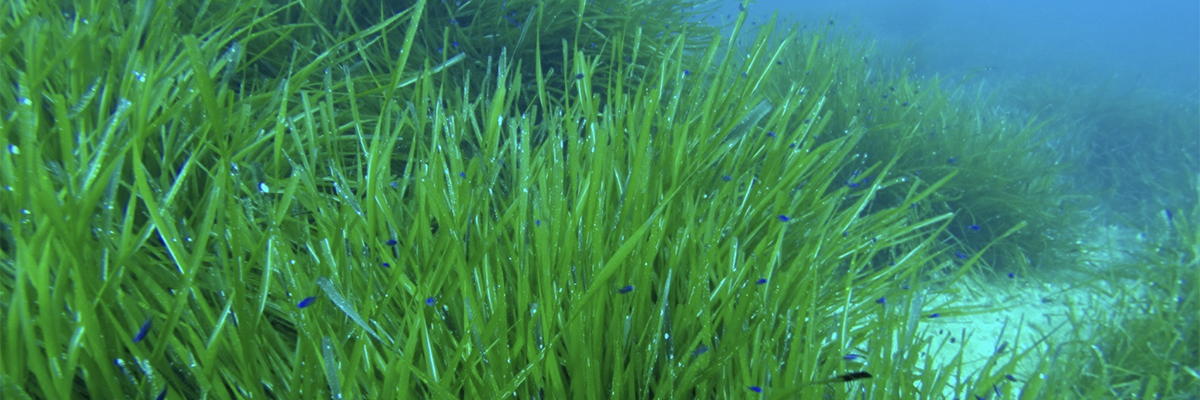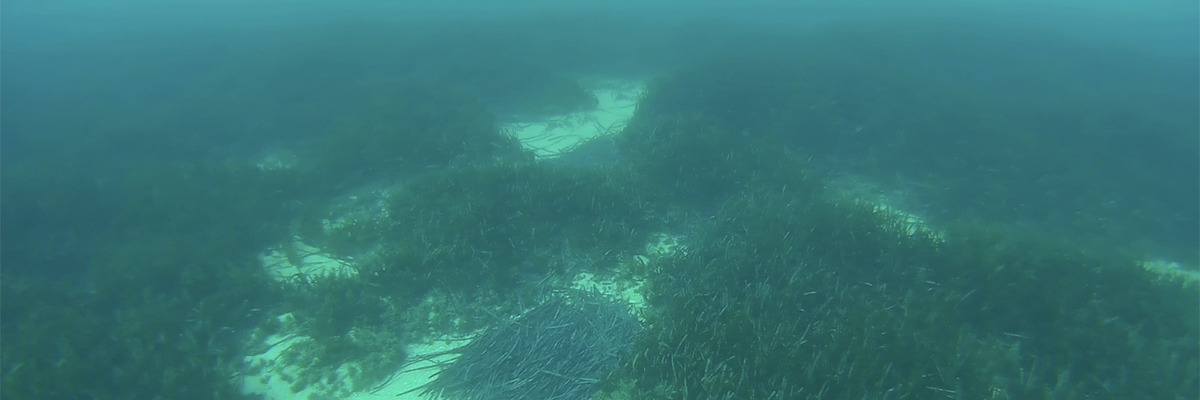This summer, there was a lot of talk about Posidonia oceanica in Sardinia and how it could be endangered by human activities such as illegal fishing and boating. For some time now, MEDSEA has been committed to safeguarding the meadows of Posidonia oceanica with "A Marine Forest to Save the Planet", which are essential for a range of benefits, from regulating sea temperatures to its ability to oxygenate the sea, from its efficiency in sequestering carbon, to its ability to protect biodiversity and be home to numerous plant and animal species, such as fish, especially in their juvenile stages. Not least is the significant role of these meadows in slowing down coastal erosion, which is also due to the effects of climate change.
That's why when the cover of these essential meadows is destroyed or simply damaged, the harm can be irreversible and incalculable. Posidonia oceanica, endemic to the Mediterranean, is a very delicate plant that grows very slowly, only a few centimeters a year. By damaging - even inadvertently and unintentionally these meadows - for example, with wild anchoring - we compromise what nature has created over centuries.

To better explain the topic, refute any doubts, and debunk some myths, we have collected some of your most frequent observations:
Why Posidonia oceanica is a protected species?
Posidonia oceanica is an endemic marine plant of the Mediterranean Sea - not a seaweed - equipped with stems, roots, leaves, and even reproductive organs, which is why it is defined as a "higher" plant (Phanerogama). It forms extensive underwater meadows, performing numerous ecological functions such as oxygen production, coastal line protection, providing habitat for marine fauna, and contributing to carbon sequestration. Its ecological importance has led to its protection through various regulations, including the Barcelona Convention, national legislation of Mediterranean countries, and the European Natura 2000 network. The main threats to this plant include boat anchoring, pollution, trawling, and coastal urbanisation.
Where can we find it?
We can find it from the first few meters of depth from the coastline up to 30-40 meters.
Can anchors really uproot marine plants like posidonia?
Yes, boat anchors and chains can physically damage posidonia meadows, a crucial marine plant for the Mediterranean coastal ecosystems. When an anchor is dropped onto the seabed where the meadow is present, it can tear and uproot the leaves, rhizomes, and roots of the posidonia. This physical damage can create "patches" or empty areas within the meadow, which can take years or even decades to regenerate due to the slow growth of posidonia.

So how should boats regulate themselves when they want to anchor in areas where posidonia is present?
Boats should follow certain guidelines and best practices when anchoring in areas with posidonia. Many protected marine areas or coastal zones have specific anchoring regulations to protect the marine environment, but even where it isn't explicitly stated, boaters can actively contribute to conserving these valuable meadows and enjoy the sea responsibly. For instance, they can directly visually inspect if the seabed presents a meadow or directly check underwater with a mask where they are anchoring, use buoy fields where available (for example, in Sinis, you can also register online at the buoy field with www.bluemooring.org). Being more informed about the benefits and importance of posidonia and sharing this information with other boaters can help promote sustainable anchoring practices.
Are there mappings of Posidonia meadows?
Yes, there are areas, particularly Protected Marine Areas, equipped with digital cartography containing information on posidonia meadows. For example, the Donia app. It's always good practice to check your boat itinerary to plan anchorages.
Is trawling (illegal) more harmful to the meadows than anchoring?
Both trawling and unregulated anchoring can have significant impacts on marine habitats if not managed correctly. While trawling can alter large areas of the seabed and negatively affect various species, careless anchoring can damage delicate habitats like posidonia meadows. Both activities, if not regulated and monitored, can lead to long-term damage in the marine environment.
To inhibit the effects of illegal trawling on seabeds that present priority species like posidonia (for example, in a Protected Marine Area or less than three miles from the area), it might be useful to adopt artificial defense systems like anti-trawling barriers positioned in the seabed. In 2023, MEDSEA, in collaboration with Flag Pescando Sardegna Centro Occidentale with the support of AMP Sinis, thanks to the reporting of local fishermen in previous years, positioned on the west coast in Sardinia - in the AMP of the Sinis Peninsula - about sixty deterrents, the first of this kind in Sardinia (SATURN project).
How to solve the "problem" of posidonia banks (also called “banquette”) that deposit on our beaches?
The presence of posidonia banks on beaches should not be considered a "problem", as posidonia plays a fundamental ecological role and its presence indicates a healthy marine ecosystem. The posidonia that settles on the beaches during certain weather conditions or marine currents is then subsequently removed by natural currents, and for this reason, it should never be removed.
Why protect posidonia when its leaves naturally detach and "pollute our beaches"?
The leaves that detach and settle on the beaches is a natural renewal process of the plant and should not be considered "pollution". As already explained, the leaves protect the beach and can help prevent erosion, acting as a natural barrier against wave action. Also, as they decompose, they release nutrients that can benefit other organisms on the beach.
Do you want to actively contribute to the reforestation of Posidonia oceanica meadows in Sardinia and throughout the Mediterranean? Support the MEDSEA campaign "A Marine Forest to Save the Planet".
Pics by Andrea Alvito / MEDSEA
Latest news

REST COAST, at the annual meeting in Groningen, demonstrates the effectiveness of natural restoration of aquatic systems
The standstill of the Nature Restoration Law, the European law on nature restoration, stalled in its final approval phase in the Council due to the hesitations of some Member States, has…

TransformAr makes a stop in Finland for the sixth Consortium Meeting
In mid-April, the sixth Consortium meeting of the H2020 TransformAr Project was held in Lappeenranta, recognized as the Climate Capital of Finland. This city truly exemplifies sustainability, with 100% of waste recycled and all…

Launch of the PLASTRON Project in Genoa: A Cross-Border Initiative for the marin Plastic & Paper Recycling
The PLASTRON project is about to start. With the goal of improving the sustainability of local communities by providing knowledge and tools for collecting and transforming plastic from the coast…

Wetland4Change to Address Climate Change with Wetlands, Kickoff in Sofia
Last week, hosted by the University of Forestry in Sofia, the kickoff of "Wetland4Change" took place, marking the start of an ambitious Interreg Euro-MED project within the Natural Heritage Mission aimed at…

The Capo Carbonara Marine Protected Area towards a New Zoning with Blue4All
A new co-management model to reorganise marine protected areas, benefiting from all the tools and knowledge provided by the Blue4All project will be soon implemented in Sardinia. Later last month, preliminary meetings…

TransformAr, Adaptation Pathways to Climate Change for Fishing Validated, All Set for Sensor Installation
TransformAr enters its most operational phase at the pilot site in Oristano where, in March, the MEDSEA team met with the Municipality of Terralba and the fishermen of the San Giovanni Lagoon from the Marceddì Consortium to…

Revitalizing the Mediterranean: ARTEMIS Project Unites Environment and Innovation
March marked the launch of "Artemis", a project of the Interreg Euro-MED Programme that seeks to combine the ecological benefits of seagrass with innovative financial strategies, such as Payment for Ecosystem…

Petit Noirs: From Senegal to Arborea to Combat Illegal Immigration with Mussel Farming
Sustainable mussel farming in Arborea becomes an international example with a project linking Dakar, Senegal, with Sardinia, aiming to combat illegal immigration and generate economic opportunities.

The Charm of Wetlands in Sardinia: Over a Thousand Visitors in the World Wetlands Day Event Calendar in Sardinia"
With over 30 events, from January 27 to March 10, 2024, the MEDSEA World Wetlands Day in Sardinia comes to a close. The initiative, which falls in the month when wetlands are…

First Meeting of the DesirMED Project in Venice: A Step Forward in Climate Adaptation in the Mediterranean
Last month, the historic city of Venice hosted the first meeting of DesirMED, a project funded by the HORIZON Europe program aimed at addressing one of the most pressing challenges of…

Sails Towards the Future: The UniCa Sailing Team and the Challenge of Eco-Sustainable Boats in Sardinia
In Sardinia, circular and low-impact solutions for water sports and sailing are being studied. The University of Cagliari, together with the UniCa Sailing Team, is working on the construction of an…

The first General Assembly kicked off in Lecce: for a more resilient MPAs network
The first General Assembly of the "Blue 4 All" project took place in Lecce from January 23 to 26, 2024. The event, hosted by the CMCC Climate - Euro-Mediterranean Center on Climate…

It's Time to Celebrate Wetlands: join World Wetlands Day Sardegna 2024
In Sardinia, February is the month of wetlands! We celebrate World Wetlands Day on the occasion of February 2nd, which marks the 53rd anniversary of the establishment of the RAMSAR Convention for…

TransformAR Reaches Halfway: The Progress in the San Giovanni Lagoon
TransformAR, at the pilot site of Marceddì-San Giovanni (Terralba) in Sardinia, one of the six demonstration sites of the project, is gaining momentum. The project, which develops transformative adaptation solutions to climate change…

MEDSEA reforestation phase in Sennariolo for the "Hope for Sennariolo" campaign has officially begun
As announced last summer, the MEDSEA reforestation phase in Sennariolo, Sardinia, for the "Hope for Sennariolo" campaign has officially begun. The small village of Montiferru in Sardinia, in July 2021, following a major fire…

We're gearing up for the month of ponds in Sardinia with #WWDSardegna: registrations open until January 21th!
At MEDSEA, we're gearing up as we do every year for the month dedicated to ponds and lagoons: February. World Wetlands Day, or the Global Day of Wetlands, is celebrated annually…
- 1
- 2
- 3
- 4


